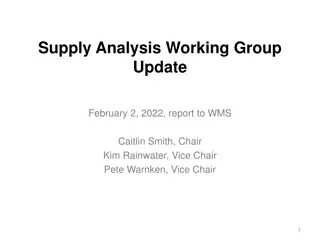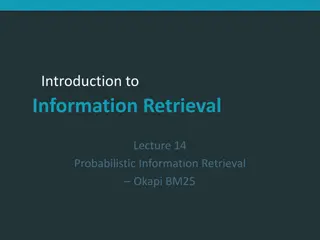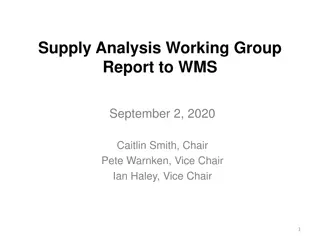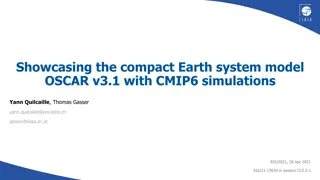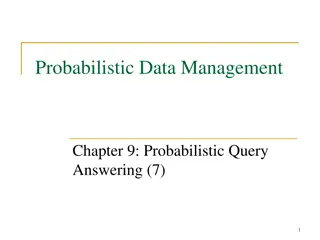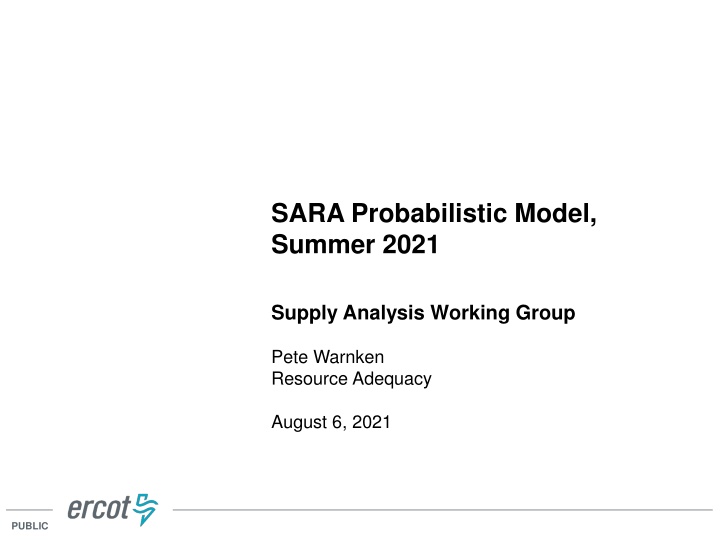
Summer 2021 SARA Probabilistic Model Updates & Major Changes
Gain insights into the Summer 2021 SARA probabilistic model updates and major changes, including new wind and solar profiles, demand distributions, and reserve margin calculations. Discover how price-responsive demand impacts capacity selections and explore simulation results for operating reserves.
Download Presentation

Please find below an Image/Link to download the presentation.
The content on the website is provided AS IS for your information and personal use only. It may not be sold, licensed, or shared on other websites without obtaining consent from the author. If you encounter any issues during the download, it is possible that the publisher has removed the file from their server.
You are allowed to download the files provided on this website for personal or commercial use, subject to the condition that they are used lawfully. All files are the property of their respective owners.
The content on the website is provided AS IS for your information and personal use only. It may not be sold, licensed, or shared on other websites without obtaining consent from the author.
E N D
Presentation Transcript
SARA Probabilistic Model, Summer 2021 Supply Analysis Working Group Pete Warnken Resource Adequacy August 6, 2021 PUBLIC
Model Updates PUBLIC
Major Model Changes New 1980-2020 hourly wind and solar profiles from UL Renewables Improved estimation of early morning and evening solar ramps Widened the probability distributions for demand and thermal forced outages to encompasses the Extreme Scenarios in the 2021 Final Summer SARA Incorporated the Summer 2021 SARA peak demand forecast and resource updates Includes planned resources with ERCOT synchronization approvals as of June 1 regardless of the summer projected commercial operations dates Updated resource quantities available to respond to Energy Emergency Alerts (down by 350 MW overall) 3 PUBLIC
Major Model Changes, continued Modified price-responsive demand (PRD) uncertainty modeling Amount of PRD capacity selected for each trial increases as the sampled load forecast amount increases A fixed amount of PRD is assigned to deciles 5 through 10 of the load forecast distribution per the following table: PRD Amount Load Forecast Beta distribution Value 65,069 73,261 74,635 Percentile 0% 0 0 0 0 0 10% 20% 75,612 76,421 77,144 77,826 78,503 30% 40% 415 829 50% 60% 1,244 1,658 2,073 2,487 70% 79,216 80,053 82,055 80% 90% 100% For example, if the sampled load forecast amount for trial 1 is 78,110 MW, the selected PRD amount is 829 MW. If the sampled load amount is 77,000 MW, the amount selected is zero MW 4 PUBLIC
Major Model Changes, continued Model now determines a distribution for each hour s pre- EEA reserve margin: Reserve Margin % = ((Total Resources Outages) - Net Demand) / Net Demand This is not the same as the CDR s Planning Reserve Margin; it is more akin to an operating reserve margin 5 PUBLIC
Simulation Results PUBLIC
Capacity for Operating Reserves Outcome Distribution, HE 5:00 PM 10,000 Trial Simulation Simulation Outcome Range: 47,257 MW to -10,728 MW Most extreme scenario for 2021 Summer SARA: -16,672 MW 7 PUBLIC
Hourly Risk Profiles, Summer 2021 vs. 2020 Hourly Risk Profile, Probability of EEAs (%) HE 1:00 PM HE 2:00 PM HE 3:00 PM HE 4:00 PM HE 5:00 PM HE 6:00 PM HE 7:00 PM HE 8:00 PM Probability of Reserves being equal to or less than the 2,300 MW EEA1 threshold Probability of Reserves being equal to or less than the 1,750 MW EEA2 threshold Probability of Reserves being equal to or less than the 1,430 MW EEA3 threshold Probability of Reserves being equal to or less than the 1,000 MW load shed threshold 0.2 2.0 5.8 7.4 11.7 7.4 8.2 15.4 0.0 0.5 1.8 2.7 5.6 3.0 3.8 7.7 0.0 0.1 0.4 0.7 1.9 0.9 1.3 3.1 0.0 0.0 0.3 0.5 1.4 0.6 0.9 2.2 Summer 2020 Simulation (For May 28, 2020 SAWG Meeting) Hourly Risk Profile, Probability of EEAs (%) HE 1:00 PM HE 2:00 PM HE 3:00 PM HE 4:00 PM HE 5:00 PM HE 6:00 PM HE 7:00 PM HE 8:00 PM Probability of Reserves being equal to or less than the 2,300 MW EEA1 threshold Probability of Reserves being equal to or less than the 1,750 MW EEA2 threshold Probability of Reserves being equal to or less than the 1,430 MW EEA3 threshold Probability of Reserves being equal to or less than the 1,000 MW load shed threshold 0.2 7.4 16.7 19.3 26.0 19.2 18.9 7.6 0.0 1.2 5.5 7.3 13.4 8.5 8.7 2.0 0.0 0.0 0.6 1.1 3.4 1.9 2.2 0.2 0.0 0.0 0.3 0.7 2.4 1.2 1.6 0.1 8 PUBLIC
Reserve Margin Comparison, HE 5:00 PM vs. 8:00 PM Reserve Margin % = ((Total Resources Outages) - Net Demand) / Net Demand Resource Margin (prior to EEA1) 5pm Resource Margin (prior to EEA1) 8pm Percentiles 0% 10% 20% 30% 40% 50% 60% 70% 80% 90% 100% -13.9% 2.5% 4.9% 6.8% 8.6% 10.4% 12.4% 14.5% 17.4% 21.9% 63.6% -12.2% 1.5% 4.4% 6.8% 9.1% 11.4% 13.6% 15.9% 18.8% 22.4% 41.4% 9 PUBLIC
Probabilistic Variable Sensitivities The tables below provide, for the key probabilistic variables, the percentage contributions to the overall variance in simulated Capacity for Operating Reserves for HE 5:00 PM Summer 2020 Simulation Summer 2021 Simulation Wind dominates the variance in a positive direction, but less than for the summer 2020 simulation Demand and forced outage variables have significant negative variance contributions that are larger than for the summer 2020 simulation, due to expansion of the probability distribution tails to encompass more extreme adverse outcomes 10 PUBLIC
Simulation-based Probabilities for the Summer SARA Scenarios Final Summer SARA Value (MW) Simulation Probability of Exceedance 48.57% Simulation Percentile Scenario Expected Load High load Extreme Load 77,144 80,178 82,055 51.43% 92.42% Undefined* 7.58% Typical Thermal Forced Outages High Thermal Forced Outages Extreme Thermal Forced outages 3,617 6,218 10,753 63.11% 96.15% 99.99% 36.89% 3.85% 0.01% Expected Wind Output Low Wind Output 8,566 1,989 45.37% 1.23% 54.63% 98.77% * The highest value selected by the model -- 81,981 MW -- was lower than the 82,055 MW scenario value. 11 PUBLIC
Recap Additions of new renewable resources, particularly solar, reduces the risk of EEA events for all hours relative to summer 2020 model results, except for HE 8:00 PM Drop-off of solar to zero MW during HE 5:00 PM now causes higher EEA risk than for all other hours; the effect of this drop-off is amplified by the doubling of installed solar capacity relative to what was reported in the summer 2020 SARA 12 PUBLIC
Unplanned Outages: SARA vs. Operations Reporting Differences Compared to Unplanned Outage reports released by the ERCOT Operations Department, the SARA: Excludes wind, solar and hydro outages since they are already accounted for in other SARA resource availability line items, and therefore reflected in SARA available resource capacity Excludes battery storage outages since battery capacity is currently given no on-peak contribution credit in the SARA Excludes PUN generator outages since outages and impacts of self- supply are accounted for in the SARA aggregate PUN capacity contribution line item and thus reflected in available resource capacity Excludes Unavoidable Extension (UE) outages classified as "Planned : these outages are treated as Planned outages in the SARA while Operations treats them as Forced: the sum of all UEs are nevertheless equal for both SARA and Operations reporting 13 PUBLIC
Thermal Unplanned Outages: SARA vs. Operations Reporting Differences, continued Compared to Unplanned Outage reports released by the ERCOT Operations Department, the SARA: Excludes outages for Switchable Generation Resources (SWGRs) unavailable to the ERCOT grid (currently Elk Units 1 and 2) since the unit capacities are already excluded as available operational capacity Excludes outages classified as Extended Outages (>180 days per "Notification of Suspension of Operations" submissions); these outages are accounted for in another SARA capacity line item in the Capacities tabs Operations reporting may reflect more recent seasonal HSLs in the Outage Scheduler than what are reflected in the SARA (minimal impact). 14 PUBLIC




